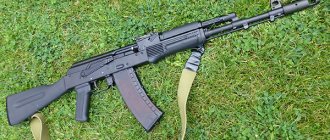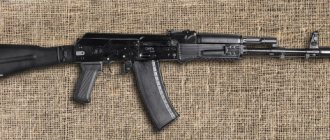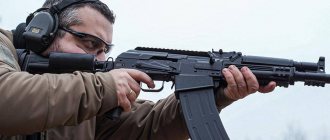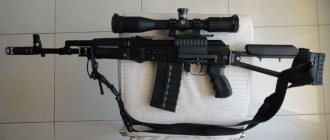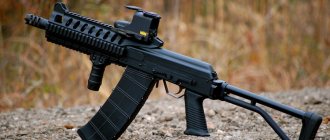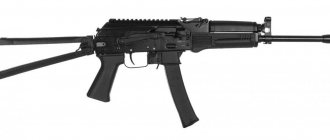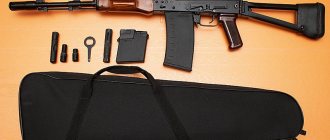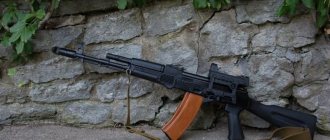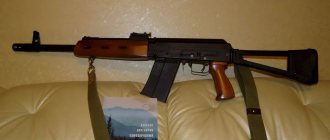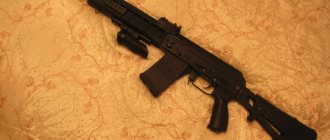One of the popular domestic carbines is the Saiga-308. This model is a hunting rifle, which was developed on the basis of the AK-74M assault rifle, but is also designed to fire . 308win (aka caliber 7.62x51). Caliber 7.62x51 is a NATO cartridge, which is the second most powerful automatic cartridge in the world. The Saiga-308 hunting carbine has a stable build quality and shows good accuracy of shots during hunting.
A very interesting fact is that almost every person who plans to buy a Saiga-308 in any version (for example, Saiga-308-1) is faced with a bunch of negative reviews about this carbine. Most of the bad reviews were written by people who not only never owned a Saiga-308, but never even held it in their hands. This category of hunters believes that any weapon that is created on the basis of a Kalashnikov assault rifle cannot even closely compare in its characteristics with hunting carbines of a classical design, which were created exclusively for hunting.
This stereotype of thinking is also supported by some hunters who generally do not consider domestic models of weapons, regardless of what cartridge they are developed for, to be worthless in comparison with foreign models. The same hunters who have been using the Saiga-308 for many years are confident that the domestic development is in no way inferior to foreign carbines of the same class, and is beyond competition in price.
Various modifications of Saiga-308
There are three main modifications of the Saiga-308, but it is also worth understanding the letter index, which is often included in the name of this rifled weapon of the Saiga series:
- "Saiga", which has the letter "M" in its name, is a modernized version of a conventional carbine;
- The letters “MK” indicate that the model has a shortened barrel. For example, "Saiga MK-308".
The main modifications of Saiga-308 are:
- "Saiga-308", which is equipped with a quick-release stock;
- Carbine "Saiga-308-1", which has an integral butt;
- "Saiga-308-2", equipped with orthopedic butts, which have a special cutout for the thumb.
In addition, there are many modifications of Saiga-308-1 in various versions. This line begins with the model “Saiga-308” version 01 and ends with the model “Saiga-308-1 version. 102.
Story
The first rifled carbines of the Saiga family appeared in the 1970s. The first samples of carbines were created by designers after an appeal from the First Secretary of the Central Committee of the Communist Party of Kazakhstan D.A. Kunaev to the General Secretary of the CPSU Central Committee L.I. Brezhnev with a request to create rifled weapons with which it would be possible to shoot migrating herds of saigas, which cause great damage to grain crops.
Prototypes of the Saiga carbine were created on the basis of the Kalashnikov assault rifle, with changes made to the design: the ability to fire only single shots, with a magazine for 10 rounds, a headlight was attached to the barrel lining, the battery was placed in the butt of the carbine, bullets without a steel core were used when firing .
Testing of the Saiga carbine was carried out in the Kazakh steppes for 4 years by Izhmash designers, representatives of Glavohota, and local game managers. After testing was completed, the plant produced about three hundred Saiga model carbines chambered for 5.6x39 mm.
In the 90s of the last century, he experienced big problems with government orders; rampant crime in the country created a demand for smooth-bore self-loading carbines for self-defense. All this served as a reason to launch the production of smooth-bore versions of the Saiga carbine.
The first smoothbore version of the Saiga carbine was the Saiga-410, chambered for the .410 Magnum cartridge, which went into production in 1993. The case length of the .410 Magnum cartridge is 76 mm (3 inches), and the caliber is 410/1000 inches, that is, 10.2 mm. The choice of such a rare caliber in our country at that time is explained by the fact that the plant’s management was primarily focused on the foreign arms market. At first, .410-caliber cartridges were in short supply, the domestic industry practically did not produce them, and imported cartridges were expensive. Then the production of .410-caliber cartridges was established at the Tula, Krasnozavodsk and Barnaul factories.
In 1995, the Saiga-20 smoothbore carbine was released, chambered for the more powerful and more popular 20-caliber cartridge in our country. The Saiga-20 carbine could be used not only for self-defense, but also for hunting. The Saiga-20 carbine has become very popular in security structures.
In 1997, the Saiga-12 smoothbore carbine was released in the most popular and widespread 12 gauge among hunters in our country. Among all the smoothbore carbines of the Saiga-12 family, it has the highest cartridge power and the best firing range. The first samples of the Saiga-12 carbine had a long barrel and a hunting butt, a little later a modification appeared with a pistol grip and a folding butt. In 1998, the Saiga-12K carbine was released with a barrel shortened to 430 mm and a trigger lock with the butt folded. On the basis of the Saiga-12K carbine, the 18.5 KS-K carbine (Kalashnikov special carbine) was created to arm special forces soldiers. Saiga 12 smoothbore carbines, thanks to their high power, short length and high rate of fire, have become the best-selling weapons among weapons intended for self-defense.
In parallel with the development and production of smoothbore carbines, Saiga continued to develop and produce rifled versions of the carbine. The Saiga-M carbine was a modernized version of the Saiga carbine. In the early 2000s, rifled carbines “Saiga-MK” and “Saiga-MK 7.62 version 30” were released, outwardly similar to the AK-103/101 and AK-104/102 combat assault rifles. Versions of the Saiga-223 carbine chambered for .223Rem and the Saiga-308 carbine chambered for .308Win were released. In addition, the plant over the years produced Saiga carbines chambered for 5.45x39, 5.56x45, 7.62x39, 9x19 Parabellum, 9x53R cartridges.
Design and main performance characteristics of Saiga-308
The Saiga-308 carbine, like all other hunting smoothbore and rifled carbines in the Saiga line, which are made on the basis of the Kalashnikov assault rifle, is distinguished by its simplicity of design, reliability in operation and low price. In addition, the Saiga-308 is assembled to a higher quality than many other rifled models of Saiga carbines. Most likely, this is a tribute to the fact that this carbine was developed taking into account deliveries abroad. "Saiga-308", shooting from which is not difficult at all, showed itself excellently on the hunt, when shooting at distances of 100-150 meters.
The process of reloading the carbine occurs due to the energy of the powder gases and the return spring. The trigger on the Saiga-308 is trigger-type, and the barrel bore and chamber are coated with a special chrome-plated compound.
The Saiga-308 handguard comes in AK and tactical types, which are equipped with Picatinny rails. The Saiga-308 magazine holds 8 rounds. In addition to the standard magazine, there are many other magazines that can hold different numbers of rounds, from 5 to 25 pieces.
The main performance characteristics of the Saiga-308 carbine are as follows:
- For shooting, .308win caliber cartridges are used;
- The barrel length is 555 mm;
- The total length of the carbine ranges from 1065 to 1125 mm, depending on the modification of the carbine;
- The weight of the weapon without ammunition is 4.1 kg;
- The magazine holds from 5 to 25 rounds, depending on the modification.
According to the factory, effective shooting can be carried out at a distance of up to 300 meters, although in practice it is better to limit it to 150 meters.
The muzzle for Saiga-308 is presented in different modifications. There are models without a flame arrester. Such modifications are not recommended for purchase by those hunters who often hunt at night, since the sheaf of sparks when shooting is very noticeable.
For those hunters who prefer models that are easy to transport, we can recommend modifications equipped with a removable stock. This stock can be easily removed due to the use of a latch, which is located on the back of the receiver.
Design Saiga-308 -1 (762 51)
The components, mechanisms and their principle of operation completely replicate the operation of similar parts of the AK series combat assault rifles. Depending on the caliber of ammunition used, the modifications contain individual differences, but the general structure of the carbine is presented in the following diagram:
Main parts of the Saiga-308 carbine
Detailed composition of the carbine:
| the name of detail | |
| 1 | Receiver assembly |
| 2 | Sector fire translator |
| 3 | Aiming block |
| 4 | Pin lining |
| 5 | Sighting bar |
| 6 | Sighting bar spring |
| 7 | Tube for removal of powder gases |
| 8 | Tube spring for removal of powder gases |
| 9 | Gas powder chamber |
| 10 | Trunk |
| 11 | Muscle block |
| 12 | Front sight platform |
| 13 | Front sight |
| 14 | Butt |
| 16 | Butt lock |
| 17 | Stock release spring |
| 18 | Stock release pin |
| 23 | Handguard |
| 24 | Screw |
| 25 | bracket |
| 26 | Magazine latch |
| 27 | Magazine latch spring |
| 28 | Magazine latch axis |
| 29 | Receiver cover |
| 30 | Bolt mechanism frame |
| 31 | Gate |
| 32 | Drummer |
| 33 | Ejector |
| 34 | Ejector bushing |
| 35 | Shock spring |
| 36 | Ejector spring |
| 37 | Striker pin |
| 38 | Ejector rod |
| 39 | Return spring guide |
| 40 | Return mechanism limiter |
| 41 | Axis |
| 42 | Return spring |
| 43 | coupling |
| 44 | Return mechanism rod |
| 45 | Store body |
| 46 | Store feeder |
| 47 | Magazine spring |
| 48 | Plank |
| 49 | Magazine cover |
| 50 | Trigger |
| 51 | Combat platoon sear |
| 52 | Cocking spring |
| 53 | Sleeve |
| 54 | Trigger spring |
| 55 | Directly trigger |
| 56 | Action spring |
| 57 | Two axes of the trigger mechanism |
| 58 | Shutter lag |
| 59 | Slide spring |
All components of the carbine are made of weapon-grade steel, especially durable plastic or hard wood. Failures of individual parts are extremely rare in practice and can be eliminated by simple replacement.
Some owners modify the carbine themselves, but the question of the legality of such actions remains open.
See also the article Dragunov sniper rifle and its performance characteristics
Operating principles of the Saiga-308 carbine, charging the carbine
The operation of the Saiga-308 rifled carbine is based on the following principle:
- The cartridge is sent into the chamber due to the movement of the bolt frame and the return spring;
- When the bolt turns, the barrel bore closes, and at that moment the trigger is cocked. At the same time, the ejector jumps over the edge of the sleeve;
- After the shooter pulls the trigger, it disengages from the sear and strikes the firing pin, which pierces the cartridge primer;
- After the shot occurs, the bolt frame rolls back along with the bolt, and the cartridge case is removed automatically and, due to the reflector, is thrown out of the receiver.
In order to fire the next shot, you need to release and press the trigger again.
In order to charge the Saiga-308 carbine, you need to follow the following algorithm:
- Put the carabiner on safety;
- Check the carbine for the presence of a cartridge in the barrel, and if there is one, remove it;
- First you need to remove the carbine magazine. To do this, you need to press the magazine latch and disconnect it;
- Load the magazine with cartridges, they are inserted one by one, and each cartridge must be pushed all the way into the rear wall of the magazine;
- Attach a loaded magazine to the carbine;
- Remove the carabiner from the safety lock;
- Pull the frame with the bolt back to the full stop and release sharply.
After this procedure, the carbine is completely ready for shooting.
Saiga carbine design
Trunk
The barrel of the Saiga carbine can be either smooth or rifled, depending on the version of the carbine. The barrel length of Saiga carbines can be from 330 to 680 mm, depending on the version of the carbine. Saiga carbines are produced for cartridges of a wide variety of calibers from .410 to 12 gauge for smoothbore versions and from 5.45x39 to 9x53R for rifled versions of the carbine.
All carbines of the Saiga family have chrome-plated bores and chrome-plated chambers. Chrome plating provides a long barrel life and simplifies weapon maintenance.
Most smooth-bore versions of the Saiga are equipped with replaceable choke constrictions, which increase the efficiency of use and expand the possibilities of using the carbine.
The barrels of some modifications of the Saiga carbine are equipped with a muzzle compensator.
Sights
Most modifications of the Saiga carbine are equipped with open sights: front sight and rear sight. Some versions of the carbine are equipped with an adjustable rib. Many modifications of the Saiga carbine are equipped with a mount for optical and collimator sights.
Automatic and shutter
The Saiga carbine is reloaded by removing powder gases through the upper hole in the barrel wall. In rifled versions of the Saiga carbine, the gas piston and rod are rigidly connected to the bolt frame. Smoothbore versions of the carbine have a completely redesigned gas release mechanism: the gas piston is a separate part from the bolt frame and can move inside the gas chamber. Mechanical decoupling of the gas piston and bolt frame allows the shooter to be protected in the event of excessive gas pressure in the gas chamber.
After the bolt frame has retreated to the required distance under the action of gas pressure, the powder gases are vented into the atmosphere through holes in the gas chamber.
Early smoothbore modifications of the Saiga carbine did not have a gas regulator and could only work with cartridges with a case length of 70 mm. Later, smooth-bore modifications of the Saiga carbine began to be equipped with a gas regulator, which allows you to regulate the volume of powder gases entering the gas chamber. The gas regulator has two fixed positions: one position for magnum cartridges, the second position for conventional cartridges. Thanks to the gas regulator, Saiga carbines began to work normally with both cartridges with a case length of 70 mm, and with semi-magnum cartridges with a case length of 73 mm and magnum cartridges with a case length of 76 mm. The most modern modifications of the Saiga carbine (Special 030, etc.) are produced without a gas regulator, but can work with any type of cartridge.
The barrel of the Saiga carbine is locked by turning the bolt, while the two lugs of the bolt fit into the grooves of the receiver. The shutter is rotated by bevelling the bolt frame. The return spring is located in the longitudinal channel of the bolt frame. The bolt handle is part of the bolt frame and is located on the right.
When the bolt is unlocked, the bolt frame of the carbine moves back and the cartridge case is initially released from the chamber. The ejection of the spent cartridge case is provided by a spring-loaded ejector and a receiver reflector. The cartridge case is ejected to the right through a window in the receiver. The automation system of the Saiga carbine has inherited high reliability from the Kalashnikov assault rifle and is capable of functioning normally even in conditions of severe contamination.
Trigger mechanism
Unlike the Kalashnikov assault rifle, Saiga carbines can fire only single shots, so the carbine does not have a self-timer mechanism: there is no self-timer tide on the bolt frame, there is no retarder in the trigger mechanism, the trigger, sear and safety switch have been changed.
Modifications of the Saiga carbine with folding stocks are equipped with a mechanism for blocking the possibility of firing a shot with the stock folded.
The most modern modifications of Saiga carbines, for example, Saiga-12K Tactics and Saiga-12S-EXP-01, are equipped with a forced slide stop, which makes it easier to reload the carbine. Some modern modifications, for example "Saiga-12S-EXP-01", have a push-button fuse instead of the traditional flag one.
Butt and forearm
Various modifications of the Saiga carbine can have butts and forends made of a variety of materials: plastic, glass-filled polyamide, multi-layer plywood, wood, metal, and have a variety of designs: classic butt, frame, folding with a pistol grip.
Shop
The Saiga carbine is equipped with a removable box magazine with a capacity of 2 to 10 rounds. The magazine capacity depends on its caliber and modification.
The Saiga family carbines have a modified magazine mounting assembly, this was done to make it impossible to insert a magazine from a Kalashnikov assault rifle into the carbine. Weapons workshops and craftsmen very often tune Saiga by installing a wide variety of magazines with different capacities and appearance.
Partial disassembly of the Saiga-308 carbine
This procedure takes place in the following sequence:
- First you need to make sure that the carabiner is not loaded and does not pose a danger. To do this, you need to carefully inspect the chamber for the presence of a cartridge there. First, the magazine is disconnected, then the carbine is removed from the safety catch, after which you need to pull the bolt back and make sure that there is no cartridge there. If present, the cartridge must be removed;
- The next step in disassembling the carbine is to disconnect the optical sight, if of course there is one. To do this, the handle of the sight bracket is rotated and the sight is removed from the receiver;
- Next, you should separate the receiver cover and remove the return mechanism from the carbine;
- The frame is separated along with the shutter. The frame is pulled back all the way, after which it is removed from the guides along with the shutter;
- Now you need to separate the bolt from the frame. To do this, the shutter must be turned counterclockwise until it disengages from the frame groove. After this, the shutter is easily removed;
- The gas tube is separated.
If the carbine is seriously dirty or in need of complete lubrication, you will need to separate the forend. This should not be done unless absolutely necessary. If you can’t separate the fore-end by hand, you need to use a special tool that comes with the Saiga-308 carbine.
Preparing Saiga MK 308-1 for shooting
Before shooting from a carbine you need:
- If the bore and chamber are covered with grease or gunpowder residue, they must be wiped dry with a soft cloth;
- Check the trigger mechanism and fuse;
- Check the reliability of the latch on several stores;
- Make a dry trigger to evaluate the operation of the gun and its moving parts.
Working with a fuse
- The fuse is turned on by moving it to the upper “S” position. This blocks the trigger;
- The fuse is turned off by moving it to the lower position “F”.
Loading and shooting
- The magazine is disconnected from the weapon by moving down and forward immediately after pressing the latch;
- The magazine is filled with cartridges. This must be done carefully and slowly: each charge must be under the flap, tightly adjacent to the rear wall of the magazine;
- The magazine is attached to the carbine;
- The fuse is deactivated. It should now be in the down position "F";
- The bolt frame is moved by hand to the rear extreme position and released. It should move to the extreme forward position;
- The sighting mechanism is set to the desired position: “1” - 100 meters to the target, “2” - 200 meters and “3” - 300 meters.
After this, the carbine is ready to fire. When the magazine runs out of cartridges, the bolt will remain in the forward position.
Incomplete disassembly of the carbine
Partial disassembly is carried out to inspect the condition of all components, clean and lubricate the weapon. This ensures its stable operation and extends its service life. The order of partial disassembly is as follows:
- Be sure to make sure the weapon is unloaded. After removing the magazine, you need to move the bolt to the rear position and check if there is a charge in the chamber;
- Remove the optics, if installed, following the instructions for using the sight;
- Remove the receiver cover and recoil mechanism. To do this, you need to recess the protrusion of the return mechanism, grab the back of the cover with your right hand, and pull it up, and then remove the cover from the carbine by moving it backwards. After this, the return mechanism is removed;
- Remove the bolt carrier and bolt. The frame must be pulled to the rearmost position and removed together with the bolt, pointing it upward from the receiver;
- Remove the bolt with the bolt frame. Taking hold of the bolt head, it must be rotated counterclockwise until the bolt diamond disengages from the figured groove of the frame;
- Remove the gas pipe. The handguard must be removed if it needs to be repaired or cleaned. To remove the forend, you need to unscrew the fastening screw using a simple screwdriver and separate it by moving it forward;
- Remove the stock. It is dismantled using a lock.
Partial disassembly must be carried out carefully and carefully so as not to damage the components of the weapon. It goes into a complete disassembly process, which we'll talk about below.
Complete disassembly of the carbine
Gun owners resort to complete disassembly in several cases. In case of severe contamination and any damage, if it is necessary to dry components after strong exposure to moisture and when the weapon is placed in long-term storage. The procedure for complete disassembly is as follows:
- Complete partial disassembly, following the above algorithm;
- Disassemble the bolt in accordance with the instructions that come with the carbine;
- Disassemble the magazine as indicated in the documentation provided with the gun.
Complete disassembly is a painstaking and responsible process. Beginners are not recommended to do it alone. To gain experience, it is better to ask for help from professional shooters or hunters with extensive experience.
Features of the Saiga-308 carbine
One of the key features of the Saiga-308 is the use of a new powerful cold-forged barrel. It is 555mm long and has thicker walls. The barrel has 4 right-hand rifling. The use of a more powerful barrel in the design forced the carbine developers to change the design of the insert, which serves to connect the box to the barrel.
In order to increase the accuracy parameters of the Saiga-308, the designers installed a new modernized shutter on it. The design of the new bolt moved away from the bolt typical of the Kalashnikov assault rifle, which has 2 locking lugs. Now the bolt has 3 protrusions, which is typical for the bolt of the Dragunov sniper rifle. The store's seating position has also been changed.
The Saiga-308 is equipped with flame arresters of a new design, similar to the flame arresters that are installed on the folding version of the SVD. Although the modernized flash arresters are shorter, their functionality is not affected. It is worth noting that most standard flame arresters, both old and new designs, cope with their responsibilities very mediocrely. Many professional hunters install homemade flash suppressors, which do a much better job.
The front sight can be adjusted both horizontally and vertically. In addition, the removable bracket allows you to install optical sights of various designs on the carbine. Using open sights, you can fire at distances of up to 300 meters, while the optical sight does not need to be removed.
Parts of the carbine, such as the fore-end and butt, have a very convenient shape, which provides the hunter with optimal advantages when shooting, although modifying individual parts of the Saiga-308 rifled carbine for a specific hunter will never be superfluous. This statement also applies to most domestic models of hunting weapons.
Technical characteristics of the Saiga carbine
- Barrel length:
330 – 680 mm - Caliber:
.410, 20, 12, 5.45x39, .223Rem, .308Win, 7.62x39, 9x19 Parabellum, 9x53R - Operating principle:
self-loading, reloading due to the removal of part of the powder gases - Magazine:
removable, box-shaped for 2-10 rounds - Length:
840 – 1170 mm - Weight:
3.2 - 3.6 kg - (JSC "Kalashnikov Concern")
Adjusting the sights of the Saiga-308 carbine and its accuracy parameters
There are two types of adjustment of sights on the Saiga-308 carbine:
- Adjustment of open sights;
- Adjusting the optical sight.
To adjust the open sights, the front sight base is moved, which can move both horizontally and vertically. Zeroing of the carbine is carried out at the shooting range, at a distance of 100 meters.
The optical sight of the Saiga carbine is set at 100 meters by default. If the scope is knocked down, which often happens when using low-quality optics, it will need to be sighted. To zero the optics, you need to use open sights.
Smoothbore modifications of the Saiga carbine
Saiga-410
The Saiga-410 carbine is the first smoothbore modification of Saiga produced by the plant in 1993. The strange choice of caliber is explained by the plant’s desire to enter the Western arms market. The Saiga-40 can hardly be called a full-fledged hunting weapon, due to too little shot or buckshot in the .410 caliber cartridge. The Saiga-410 carbine is most often fired with bullet cartridges. Saiga-410 carbines were most often purchased for the purposes of self-defense and arming security personnel. The Saiga-410 carbine was equipped with a plastic or wooden hunting butt and fore-end. The barrel length of the Saiga-410 carbine is 570 mm, the total length is 1170 mm, the weight of the carbine is 3.4 kg.
Saiga-410S
The Saiga-410S carbine is a modification of the Saiga-410 carbine with an automatic plastic stock folding on the left side, a plastic pistol grip, a hunting-type fore-end, an open front sight at the end of the gas outlet tube and a non-adjustable rear sight. The barrel length of the Saiga-410S carbine is 570 mm, the total length is 1080 mm, the length with the butt folded is 840 mm, the weight of the carbine is 3.4 kg.
Saiga-410K
The Saiga-410K carbine is a modification of the Saiga-410 carbine with a shortened barrel and a folding butt. When the stock is folded, it is impossible to fire a shot, since the firing mechanism is blocked. Sights in the form of an open front sight at the far end of the gas tube and a non-adjustable rear sight. The barrel length of the Saiga-410K carbine is 330 mm, the total length is 840 mm, the length with the butt folded is 595 mm, the weight of the carbine is 3.3 kg.
The Saiga-410K carbine is presented by the manufacturer in various versions:
- Saiga-410K isp. 01 —
modification of the Saiga-410K carbine with a 404 mm long barrel, a folding plastic butt and plastic handguards and a gas tube cover. Sights in the form of an automatic front sight in a muzzle at the end of the barrel and a two-position rear sight for two fixed positions: 25 and 50 meters. In appearance, this version of the carbine resembles the AK-74M assault rifle. The total length of the Saiga-410K carbine is used. 01 - 910 mm, length with the butt folded 670 mm, carbine weight 3.1 kg.
- Saiga-410K isp. 02
modification of the Saiga-410K carbine with a 404 mm long barrel, a folding metal or plastic frame stock and wooden or plastic handguards and a gas tube cover. At the end of the barrel there is a muzzle brake-compensator. In appearance, this version of the carbine resembles an AK-74S assault rifle. The total length of the Saiga-410K carbine is used. 02 - 910 mm, length with the butt folded 670 mm, carbine weight 3.3 kg.
- Saiga-410K version 03
modification of the Saiga-410K carbine with a 351 mm long barrel, a folding plastic butt and a plastic forend. At the end of the barrel there is a muzzle, the front sight is mounted on the gas outlet tube. In appearance it resembles a small-sized AK of the “hundredth series”. The total length of the Saiga-410K carbine is used. 03 - 825 mm, length with folded stock 585 mm, carbine weight 3.2 kg.
- Saiga-410K isp. 04
modification of the Saiga-410K carbine with a 351 mm long barrel, a folding metal frame stock and a plastic or wooden fore-end and gas tube cover. In appearance it resembles the AKS-74U. The total length of the Saiga-410K carbine is used. 03 - 825 mm, length with folded stock 585 mm, carbine weight 3.2 kg.
You can learn more about the Saiga-410 carbine in our article: Saiga-410 carbine
Saiga-20
The Saiga-20 carbine is equipped with a hunting plastic or wooden butt and fore-end. The barrel length of the Saiga-20 carbine is 570 mm, the total length is 1135 mm, the weight of the carbine is 3.5 kg. Carbine Saiga-20 isp. 30 is equipped with a hunting quick-release wooden stock and fore-end, a 680 mm long barrel with interchangeable choke tubes, and an adjustable sighting rib. Since 2022, Saiga-20 carbines have been discontinued.
Saiga-20S
The Saiga-20S carbine is a modification of the Saiga-20 carbine with a folding plastic stock, a fire control handle and a hunting-type forend. The barrel length of the Saiga-20S carbine is 570 mm, the total length is 1050 mm, the length with the butt folded is 810 mm, the weight of the carbine is 3.5 kg.
Saiga-20K
The Saiga-20K carbine is a modification of the Saiga-20 carbine with a shortened barrel and a folding butt. The barrel length of the Saiga-20K carbine is 430 mm, the total length is 910 mm, the length with the butt folded is 670 mm, the weight of the carbine is 3.2 kg. Carbine Saiga-20K isp. 04 has a folding plastic stock and fore-end, a 400 mm long barrel with replaceable choke tubes, and an 8-round magazine.
Saiga-12
The Saiga-12 carbine is produced in the most popular and in demand among hunters 12 gauge. The barrel length of the Saiga-12 carbine is 580 mm, the total length is 1145 mm, the weight of the carbine is 3.6 kg.
The Saiga-12 carbine is presented by the manufacturer in a large number of different versions:
- Saiga-12 Spanish
61 is equipped with a hunting stock and a plastic forend. - Saiga-12 Spanish
65 is equipped with a detachable buttstock and forend made of plastic, replaceable muzzle nozzles, and an adjustable sighting bar. - Saiga-12 Spanish
71 is equipped with a hunting stock and forend made of wood, replaceable choke tubes - Saiga-12 isp.75
is equipped with a hunting quick-release wooden stock and fore-end, a 580 mm long barrel with replaceable choke tubes, and an adjustable sighting bar. - Saiga-12 Spanish
78 is equipped with an AK-type stock and a hunting forend made of plastic and a handle. - Saiga-12 Spanish
85 is equipped with a quick-release stock and a hunting forend made of wood. - Saiga-12 Spanish
102 receiver is closed with a plastic casing, with which the butt and fore-end are smoothly connected, there is a push-button safety - Saiga-12 Spanish
103 is equipped with a plastic butt, a hunting fore-end, a reinforced plastic receiver cover, a convenient push-button safety, and a unified base for mounting a sight. - Saiga 12 isp.
261 is equipped with a magazine receiver, a buttstock with a rotating cheekpiece of the SVD type, a plastic forend, interchangeable choke tubes and a rail on the receiver for mounting a sight. - Saiga-12 Spanish
265 is equipped with a magazine receiver, a detachable stock and a plastic forend - Saiga-12 Spanish
271 is equipped with a magazine receiver, a hunting stock and a wooden forend - Saiga-12 Spanish
275 is equipped with a magazine receiver, a detachable stock and a wood forend. - Saiga-12 Spanish
The 278 is equipped with a magazine receptacle, an AK-style plastic stock and pistol grip, and interchangeable choke tubes. - Saiga 12 isp.
340 smoothbore self-loading shotgun, created for the needs of IPSC athletes. - Saiga-12 EXP-01
modification similar to the Saiga-12K carbine. 030. The modification is intended for export for arming law enforcement agencies. The barrel length is 430 mm, equipped with a bolt stop; the carbine does not have a firing lock with the butt folded. It is not a civilian weapon and is prohibited for sale to citizens on the territory of the Russian Federation.
Saiga-12S
The Saiga-12C carbine is a modification of the Saiga-12 carbine with a folding plastic stock, a fire control handle and a hunting-type forend. The barrel length of the Saiga-12S carbine is 580 mm, the total length is 1060 mm, the length with the butt folded is 820 mm, the weight of the carbine is 3.6 kg.
- Saiga-12S isp.
10 has a folding stock, a plastic forend, a 680 mm long barrel with interchangeable choke tubes and an adjustable rear sight. - Saiga-12S isp.
031 is an 18.5 KS-K smoothbore service carbine with an added fire blocker in the folded position. The carbine has a magazine receiver, a hinged receiver cover, a rail for mounting optics, a folding stock and a plastic forend.
Saiga-12K
The Saiga-12K carbine is a modification of the Saiga-12 carbine with a shortened barrel and a folding butt. The barrel length of the Saiga-12K carbine is 430 mm, the total length is 910 mm, the length with the butt folded is 670 mm, the weight of the carbine is 3.5 kg.
The Saiga-12K carbine is presented by the manufacturer in a large number of different versions:
- Saiga-12K isp.030
is a service smoothbore 18.5 KS-K carbine with an added fire blocker in the folded position. The carbine has a magazine receiver, a hinged receiver cover, a rail for mounting optics, an automatic bolt stop, a folding stock and a plastic fore-end. Two additional Picatinny rails at the bottom of the forend and on the barrel under the gas block. The two-position gas regulator was excluded from the carbine's automatic system. - Saiga-12K isp.033
, this modification has a shortened barrel with a length of 330 mm, is equipped with picatinny rails, and is equipped with a specially designed muzzle attachment. - Saiga-12K isp.040
is one of the most interesting modifications of Saiga-12. Produced by a subsidiary of the Izhevsk Machine-Building Plant. It has a magazine receiver neck, a non-removable receiver cover mounted on an axis, a manual or automatic bolt stop, and a Picatinny rail on the receiver. - Saiga 12 K isp.
043 has a magazine receptacle, an adjustable sighting bar, a folding machine gun stock and a plastic forend.
You can learn more about the Saiga-12 carbine in our article: Saiga-12 carbine
Real reviews from owners of the Saiga-308 carbine
Although the Saiga-308 is certainly a very reliable and trouble-free weapon, its accuracy is not a parameter of pride for its owners. Judging by the feedback from fishermen, at a distance of 50-75 meters, “Saiga-308” produces a completely acceptable “pile”, but if the distance to the animal exceeds 100 meters, and this animal is also in motion, then hitting it will be very problematic. This problem can, of course, be reduced by “tuning” the carbine, but this will require “direct hands” or the help of more skilled users of this carbine. On specialized hunting forums there is a lot of information on independent modernization of the Saiga-308 carbine.
The Saiga is a fairly inexpensive weapon, but in recent years it has been under strong pressure from the competing Vepr carbine, which is produced by . Although the price of the Vepr is significantly different from the price of the Saiga, its accuracy is higher. For those who like to independently modify weapons, Saiga-308 represents an opportunity for limitless tuning. Unlike other modifications of the Saiga, the 308 caliber model was developed taking into account the wishes of hunters, so its accuracy is slightly higher than that of other modifications.
If we consider the Saiga-308 as a weapon for hunting, then its potential is widely revealed in driven hunts, where rate of fire is valued and distances do not exceed 100-150 meters. At such a distance, the Saiga-308 works no worse than the same Vepris or even Tigers, and for the price it is generally an excellent option. A huge advantage of this weapon is its compactness, which in the version with a folding stock has no competitors at all.
At the end of May of this year, I purchased a second rifled carbine for collective driven hunts - this is Saiga-308-1 in 61st 415 barrel ). For a long time I have wanted to acquire a semi-automatic weapon in a more powerful and, in my opinion, universal caliber than 7.62x39 , but for a reasonable price. Looking ahead, I will say that I have not yet regretted my choice and I hope that I will not regret it in the future. In this article I will share my impressions of the purchased weapon and try to justify why I gave my preference to the Saiga in 308 caliber.
So, this carbine cost me 35,800 rubles. This is by far the most affordable offering of semi-automatic rifled carbines in .308 Win .
Video version
Why did I choose Saiga in 308 caliber?
1. Saiga, in my opinion, is a simple, reliable, unpretentious, quite convenient and affordable carbine, which I don’t mind, for example, dropping into a puddle and scratching while hunting in the forest. After all, I need a weapon, first of all, for hunting, and not to blow off specks of dust from it and be upset about every new scratch or chip. Also, to the positive qualities you can add maintainability and availability of spare parts.
2. Not bad, for the money, characteristics for collective driven hunts:
— caliber .308 Win ;
- semi-automatic;
- spacious stores;
— the weapon is compact and not heavy.
The accuracy declared by the manufacturer (according to the passport 76 mm per 100 m) is enough for me, since during round-up hunts in our area, due to poor visibility, I have to shoot at the animal at short distances, usually no more than 100 meters, more often up to 50 meters.
Accuracy of my Saiga-308-1 at 100 meters, BPZ HP cartridges 9.7 g.
3. Saiga easily digests inexpensive domestic cartridges, or rather, it was created for them. Since, in addition to hunting, I also periodically visit the shooting range, for me the cost of ammunition is a significant argument in the matter of choosing a weapon. For comparison: I buy (current for mid- 2020 ) BPZ HP 9.7 g . at 23.5 rubles/piece, BPZ SP 10.9 g at 22.85 rubles/piece, and BPZ FMJ 9.4 g at 20.85 rubles/piece, while Imported ammunition starts at 150 rubles per piece and the price tag can reach up to 700 rubles per cartridge! It turns out that in the current economic realities, you can’t really get enough of imports.
4. Tuning possibilities. But I don’t plan to bother with this yet, maybe in the future I’ll take up this issue. So far, today I have only bought a SAG a Holosun HS403R red dot sight , a Dolg-M2 and a 5 Pufgun magazine , which, by the way, does not snap onto my carbine (I will have to file it).
My impressions after purchase
In short, I like this purchase. I think I made the right choice. The only thing I want to note is a couple of nuances.
1. The butt is short. I find its length a little short for comfortable aiming. But I will solve this problem in the near future by installing a butt plate.
2. The fire selector is too tight and not very ergonomic. But I think that over time it will be developed and the issue will disappear.
Otherwise, I repeat, I am happy with the purchase. I tested this unit at the shooting range and am satisfied with everything, it met my expectations.
I think that for the money, Saiga-308-1 in 61 is a worthy weapon and a good choice for hunters on collective driven hunts.
UPD 06/20/2020 . Today I was at the shooting range and shot with my Saiga at 150 meters.
By the way, I removed the crown with a collimator several times the day before and, to my surprise, the STP was preserved!
First series of 3 shots
Second series of 3 shots
Third series of 4 shots
Today I shot with bulk cartridges from the Barnaul Cartridge Plant, 10 pieces of HP 9.7 g and 4 SP 10.9 g. The last ones, I aimed too high, it was possible to take them exactly in the center.
This is what I got at 150 meters
Tomorrow I'll shoot gongs at 300-330 meters.
UPD 06/21/2020 . Today we shot from a distance of 258 meters at a 30x20 cm gong. Unfortunately, it didn’t work out at 300 meters yet. But it was not easy, but very interesting and exciting.
The gong, of modest size, I repeat, 30 by 20 cm, at such a distance, was not easy to see with the naked eye, and aiming without optics was even more difficult.
But my Saiga showed itself very well. I managed to hit the gong 10 times out of 16 shots, my father hit 2 out of 3 , Eduard 1 out of 3 . We shot with BPZ HP 9.7 g , standing from the rest on the power bumper of our 80 .
I think this is a very good result for the cheapest 308 caliber semi-automatic carbine and one of the cheapest cartridges. In short, I was very pleasantly surprised; I didn’t expect the Saiga-308-1 to shoot so well!
UPD 09.30.21 . Finally, before the upcoming hoof hunting season, I got around to finishing the 5-seater magazine from Pufgun , which did not want to function normally on my carbine (as I wrote above, it did not fit into the shaft all the way and did not latch, I had to forcefully push until it stops). Using the cheapest needle files from a construction supermarket, I solved this problem in 5 minutes. The problem lay in an excessively thick support protrusion, which did not allow the lock (lock/latch) of the magazine to snap into place and, thereby, fix the magazine in the desired position. In short, I had to use a file to make a small groove, about 1 mm deep, on the supporting ledge.
I didn’t bother with aesthetics at all, but now the store runs like clockwork. Honestly, it’s a little strange that Pufgun made for Saiga in 308 caliber do not fit out of the box on this carbine as they should. Maybe I don't understand something? Why is that?
Question price?
This unit with all the accessories and paperwork cost me 64,920 rubles.
07/06/2020 bought an Alfa Arms for 1300 rubles and a Top
for 250 rubles. In total, I spent 66,470 rubles on everything.
Specifications
(data from the official website)
• Magazines: 2 pcs. • Barrel length, mm: 415 • Caliber: .308 WIN • Item number: 201400901221 • Code: SK-308 KOM61 P • Forend material: plastic • Folding buttstock, impact-resistant polymer • USM lock: Yes • Mounting of optical devices: side strap • Barrel rifling pitch: 315 mm • Thread standard on the muzzle: SpM24x1.5 • Muzzle device is removable, brake compensator • Sighting rib, divisions: 10 • Butt material: plastic • Weight (with magazine, without cartridges), kg 3.8 • Height, mm 190 • Width, mm 70 • Type of sighting device: open, mechanical • Availability of slide stop: manual • Type of automation: gas-operated with long stroke of the piston • Barrel bore coating (material/thickness): chrome • Availability of mounts for attachments : Picatinny rails on the forend • Length with stock folded, mm 665 • Length with stock unfolded, mm 900
Impressions and experience while hunting
UPD 03.11.21. I hunted with this carbine for the hunting season in 2022 and a little in 2022, and today I have managed to form some opinion about Saiga in 308 caliber, or more precisely about its practical use in round-up hunts. In principle, so far I have never regretted that I purchased this “thunder stick”, especially after making minor modifications to it.
Perhaps I’ll first start with the advantages of Saiga
1. Standing on the “number” with it is quite comfortable, especially together with a tactical 3 -point belt (such as Dolg-2 or something similar), thanks to which the weapon is located on the chest, in a convenient position for quickly throwing it up, in in the event of an unexpected appearance of an animal, while the hands, until the moment of using the weapon, are free and calmly resting.
2. The dimensions, weight and form factor of the weapon are convenient, the carbine is quite compact (only 90 cm in working condition) and, in my opinion, quite useful. Thanks to this, it is very convenient to move with it, aim and fire in cramped conditions, for example in thickets of vegetation.
3. Simple and reliable mechanics, unpretentious to operating conditions and weather. Dirt, snow and puddles are not scary. Don't mind dropping, hitting, etc. At the same time, it is very pleasant to know that the weapon will not fail in any situation.
4. Thanks to the rifle caliber ( 7.62x51 ), it handles animals well. I can’t say about large animals, such as bears and elk, since such animals are not found in my region, but it copes well with deer weighing 200 kg and wild boars. With a good hit, it leaves them no chance, even with simple Orthodox cartridges, such as Barnaul and the like.
5. The semi-automatic fire mode on the paddock is also not unimportant. It happens that it is not possible to hit a running animal in the first place or at all, especially when it breaks through bushes and trees. Therefore, the ability to quickly fire a second shot is critical. The bolt is not convenient in this situation, especially with a long bolt stroke. With Saiga, everything is fine with the rate of fire, just have time to pull the trigger).
What can I say about the shortcomings
So far I have discovered one unpleasant drawback for myself - the loud fire mode translator. Therefore, on the “number” I immediately remove the fuse as soon as the beaters start working. But I’m used to this drawback, because in addition to Saiga, I also have an AKMS-MF1 , with which I have been successfully hunting since 2012 , but there the fire translator works softer and quieter.
So, what have I gotten from it so far: 4 deer, weighing from 90 to 200 kg and 2 small gilts.
I will continue to use this “thunder stick” and as new impressions appear, I will add to this article.
That's all for today, thanks for your attention!
You might be interested in:
Wolf (part 2). Wolf pack and its orders
A pack of wolves Continuation of the story about wolves.
In this article we will look at the social behavior and relationships of wolves living in a pack. Let's find out what a wolf pack is, what its orders are, what hierarchy is and how it manifests itself. Let's look at the structure and ranks in the pack. Also, briefly, let’s look at how wolves communicate and interact with each other. What is dominance and submission in a wolf pack. How and why wolves constantly play with each other. And also how they hunt, distribute and store food. Read more…
Quail hunting, Ai-Petri, 2022. Second exit
Quail hunting, Ai-Petri, Crimea 2020
Our second quail hunting this season. We visited the same wonderful places where we successfully opened this hunting season. This Ai-Petri mountain plateau is one of the most picturesque places on the Crimean peninsula! A majestic and practically untouched corner of Crimean nature, with a rich flora and fauna, capable of conquering anyone with its beauty and pristine nature. Also, in addition to the stunning landscapes, these places attract many hunters with the abundance and variety of different game. In my opinion, you probably won’t find a better place for quail hunting in Crimea. On these spacious and picturesque yailas, the quail rests during the day and gains strength before the upcoming night flight across the Black Sea.
Read more…
Hunting hare
Brown
hare The brown hare in Crimea is found everywhere where there is vegetation, most often in the foothills, gardens, vineyards, and yayla. The hare does not like continuous old forests: there is less food in them than in the surrounding lands.
Hunting for hare is very popular among hunters, as it is very exciting and sporty; it requires a lot of energy for walking across fields and mountain slopes, as well as observation, vigilance, the ability to read tracks, and shoot quickly and accurately.
Read more…
Share with friends!
Disadvantages of the Saiga carbine
Despite all the advantages, the Saiga family carbines also have a number of significant disadvantages:
- The Saiga carbine is not suitable for hunting. Due to the rather short barrel (in most modifications) and the gas-operated principle of automatic operation, the Saiga carbine has far from the best accuracy and accuracy of combat. Experienced hunters prefer to use other hunting weapons for hunting. Still, first of all, Saiga is a weapon of self-defense and a weapon intended for recreational shooting, and not a hunting weapon.
- The Saiga carbine, due to the peculiarities of its ergonomics, is poorly suited for shooting offhand, shooting at moving targets and shooting at long distances.
- The Saiga carbine is quite heavy, which makes it poorly suited for long-term walking hunting.
Saiga rifled hunting carbines
There are various modifications of Saiga rifled carbines:
- Saiga
- the absence of an index in the name indicates the initial modification of the carbine with a barrel length of 520 mm for calibers 5.56x45 mm, 7.62x39 mm, 5.6x39 mm and a barrel length of 555 mm for calibers 7.62x51 mm and 9×53 mm. The basic modification of the Saiga rifled carbine is equipped with a wooden hunting butt.
- Saiga Spanish
02 modification of the carbine with a hunting plastic butt and a short plastic forend like AK. The barrel is shortened, 415 mm long. - Saiga Spanish
03 modification of a carbine with a hunting wooden or plastic butt and fore-end. The barrel is shortened, 415 mm long. - Saiga Spanish
04 is a modification of the carbine in which the handle, fore-end, gas chamber cover and permanent stock are made of wood or plastic, similar to the AK-74 assault rifle. The barrel is shortened, 415 mm long, equipped with a flash suppressor. - Saiga M is
a modernized modification of the Saiga rifled carbine. Produced in calibers 7.62x39 and .223Rem, barrel length 555 mm. The Saiga M carbine chambered for 7.62x39 caliber had a bolt with three lugs. The Saiga M carbine had a trigger mechanism with a reduced trigger force and was equipped with an ergonomic wooden butt with a rubber butt pad. - Saiga-M1
is a modification of a carbine with a hunting quick-release wooden or plastic butt and fore-end. - Saiga-M2
is a modification of the carbine with an orthopedic wooden butt, rubber butt and fore-end. - Saiga-M3
is a modification of the carbine with a folding plastic stock and an AK-type forend. The carbine front sight block has a short slotted flash hider with a barrel length of 555 mm or a long slotted flash hider with a barrel length of 520 mm. - Saiga M3 “Praktika”
is a modification of the carbine with a folding buttstock adjustable in length and a rotating cheekpiece. The carbine is equipped with a side Picatinny rail on the receiver and a Picatinny rail on the receiver cover. Magazine neck with guide for quick and easy magazine change. - Saiga M3 EXP 01
is a modification of the carbine intended for export for arming security structures, convoy units and law enforcement services. The Saiga M3 EXP 01 carbine is created on the basis of “police” modifications of the Kalashnikov Ak-103-1 / Ak-101-1 assault rifle and is not intended for sale to citizens.
- Saiga MK
is a modification of the Saiga rifled carbine with a shortened barrel, length 336 or 415 mm and a lock for firing with the butt folded.
Created on the basis of the AK-74M assault rifle and its further modifications AK-101 and AK-103. Saiga-MK Spanish
01 carbine is equipped with a black polyamide stock, handle, fore-end and barrel guard, like those of Kalashnikov assault rifles of the hundredth series. - Saiga-MK Spanish
The 02 carbine is equipped with parts borrowed from the AKS-74 assault rifle: metal, frame-type folding stock, wooden fore-end and receiver guard, fire control handle made of brown plastic. - Saiga-MK Spanish
03 (or Saiga-MK-223 isp.03, or Saiga-MK-03) has a 336 mm long barrel chambered for the .223 Remington cartridge (5.56×45 mm), equipped with a lock for firing a shot in the folded position. The carbine is very similar to the AK-102/AK-104 assault rifle and is very popular as a weapon for self-defense. - Saiga-MK Spanish
30 has a 415 mm barrel chambered for 7.62x39 and 5.45x39 cartridges, is equipped with a cartridge guide, a removable flash hider, a safety lever with an additional protrusion, a side Picatinny rail, a Picatinny rail on the right and lower parts of the plastic forend, a sighting bar with markings up to 1000 meters . - Saiga-MK Spanish
33 has a 341 mm barrel chambered for 7.62x39 and 5.45x39, is equipped with a cartridge guide, a removable flash hider, a safety lever with an additional protrusion, a side Picatinny rail, Picatinny rails on the right and lower parts of the plastic forend, a sighting bar with markings up to 500 meters .
- Saiga-5.6 (Saiga-5.6S)
is a rifled carbine of the Saiga family chambered for the 5.6x39 hunting cartridge. The Saiga-5.6 carbine has been in production since 1974 and was discontinued due to frequent failures of the automation system resulting from too much bevel of the cartridge case and poor demand for the carbine chambered for this cartridge from hunters. - Saiga-308
is a rifled carbine of the Saiga family chambered for .308Win (7.62x51 mm).
Saiga-308 isp.
46 has a folding plastic stock, similar in appearance to Kalashnikov 100 series assault rifles, barrel length 350 mm. - Saiga-308 isp.
61 has a folding plastic stock, similar in appearance to Kalashnikov 100 series assault rifles, barrel length 415 mm.
modification of the Saiga carbine chambered for: 9×19 Parabellum, 9×21 mm, 9×53 mm. The Saiga-9 carbine chambered for 9x19 cartridge is produced on the basis of the PP-19-01 Vityaz-SN submachine gun. The automatic action of the carbine operates according to a blowback mechanism; the gas outlet tube performs only a decorative function. The carbine's barrel is extended, the magazine holds 10 rounds, the trigger allows firing only single shots, and the possibility of firing with the stock folded is blocked. The Saiga-9 carbine chambered for 9×21 mm is produced for export sale. The Saiga-9 carbine is produced under the 9x53 mm cartridge. Domestic 9x53 cartridges are very difficult to find on sale, and imported cartridges are many times more expensive than domestic ones and also have higher power, which negatively affects the operation of automation.
- The SR1 carbine
is a self-loading carbine based on the AK-107 assault rifle, designed for competitive shooters. Previously called Saiga-107. - The TR3 carbine
is a self-loading rifled carbine chambered for 5.45×39 mm and 7.62×39 mm calibers, produced on the basis of the AK-12 assault rifle. Previously called Saiga-AK12. - The TR9
Paradox carbine is a smoothbore hunting self-loading carbine chambered for 345TK cartridge, produced on the basis of the Saiga-9 carbine. 02.
Advantages of the Saiga carbine
The Saiga carbine has many advantages, for which it is highly valued by its owners.
- The Saiga carbine, thanks to its design and operating principle of automation, inherited from the Kalashnikov assault rifle, is distinguished by its high reliability and unpretentiousness, the ability to work in the harshest conditions.
- The Saiga carbine is quickly and easily disassembled and assembled, repairing the carbine is not difficult, and spare parts for Saiga can be purchased at any gun or hunting store or ordered online.
- Thanks to the self-loading operating principle and high magazine capacity, Saiga has a high rate of fire, which can be important both for self-defense and for certain types of hunting.
- The Saiga's fairly large weight and gas-operated operating principle provide the carbine with relatively low recoil.
- The Saiga carbine provides great opportunities for its tuning; the owner can install sights of various types on it, change the stock and fore-end, install various body kit elements, thereby individualizing it and adjusting it to his requirements.
Saiga carbine tuning
The Saiga carbine provides its owners with great tuning opportunities. On sale you can find a large number of spare parts and tuning elements for Saiga.
The Saiga owner can replace the wooden stock with an impact-resistant plastic stock, or vice versa, replace the plastic parts of the fore-end and handle with wooden ones, and change the stock with a metal frame one.
Most modifications of the Saiga carbine have one or more rails designed for mounting an optical, collimator sight, night vision sight or thermal imager.
Many Saiga owners install high-capacity magazines, laser designators, front sights, flame arresters, and bipods on their carbine.
Tuning the Saiga carbine allows the owner to adjust the weapon to his individual requirements.
